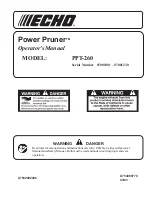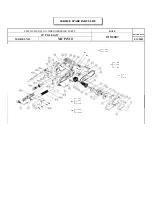
Page 10
GENERAL CUTTING
See Figure 7.
Hold your saw firmly in front of and clearly away from you.
Make sure saw blade is clear of any foreign material and that
power cord and extension cord are out of the blade path. Be
sure material to be cut is held firmly. Small work pieces should
be securely clamped in a vise or with clamps to the work
bench or table. Mark the line of cut clearly. Depress the trigger
switch starting the cutting action, set the base assembly
against the work, then move the blade into the work. DO NOT
FORCE. Use only enough pressure to keep the saw cutting.
Let the blade and saw do the work.
PLUNGE CUTTING
See Figure 8.
Mark the line of cut clearly. Choose a convenient starting
point inside the area to be cut out and place the tip of the blade
over that point. Rest front edge of base assembly on work and
hold firmly in position.
WARNING:
Make sure blade does not touch work until motor reaches
full speed, since this can cause loss of control resulting in
serious injury.
With saw blade at full cutting speed, slowly tilt saw downward
until tip of blade starts cutting work. After blade penetrates
work, tilt saw until blade is perpendicular to the work.
OPERATION
METAL CUTTING
See Figure 9.
Metals such as sheet steel, pipe, steel rods, aluminum, brass,
and copper may be cut with your saw. Be careful not to twist
or bend the saw blade. DO NOT FORCE. We recommend
cutting oil when cutting most soft metals and steel. Cutting oil
will also keep blades cool, increase cutting action, and
prolong blade life.
Never use gasoline since normal sparking of motor could
ignite fumes. Clamp the work firmly and cut close to the
clamping point to eliminate any vibration of the work being
cut. When cutting conduit pipe or angle iron, clamp work in a
vise if possible and cut close to the vise. To cut thin sheet
material, "sandwich" the material between hardboard or
plywood and clamp the layers to eliminate vibration and
material tearing.
6
6
6
Fig. 9
Fig. 7
Fig. 8
Hold tool by insulated gripping surfaces when performing
an operation where the cutting tool may contact hidden
wiring or its own cord. Contact with a “live” wire will make
exposed metal parts of the tool “live” and shock the
operator.
WARNING:






























